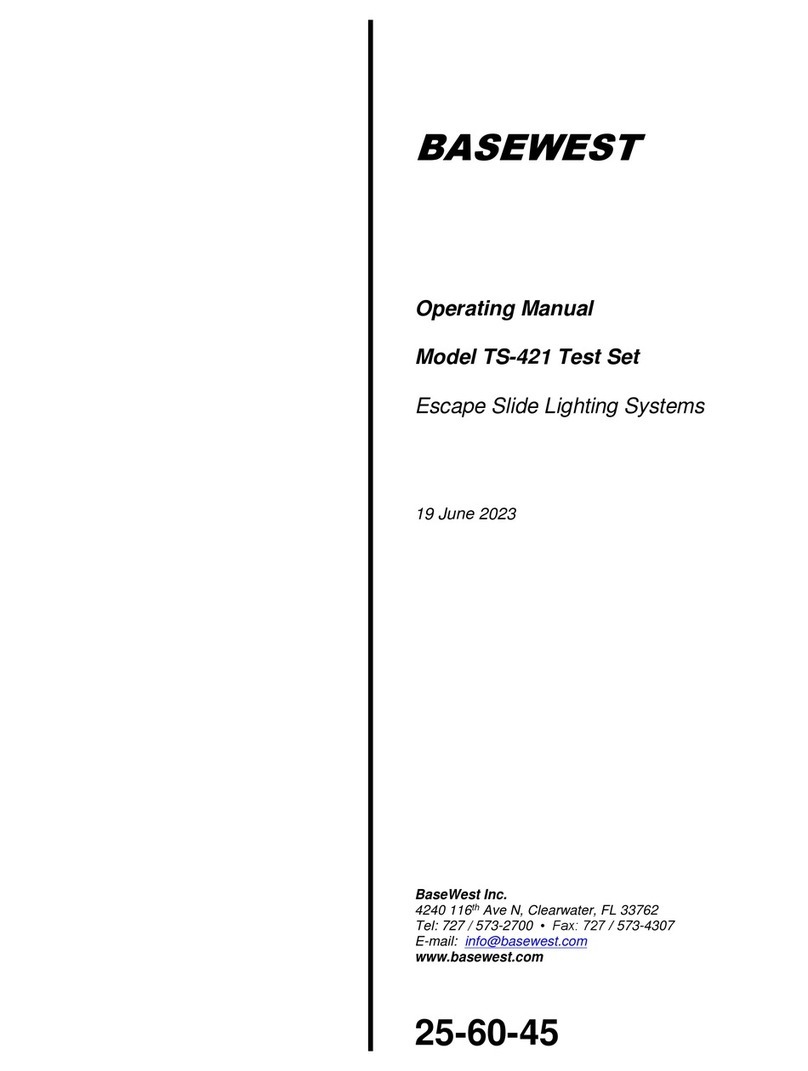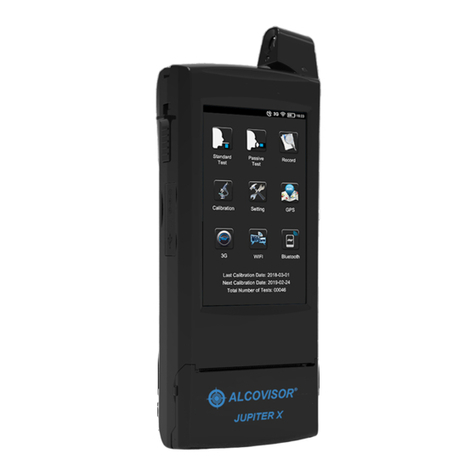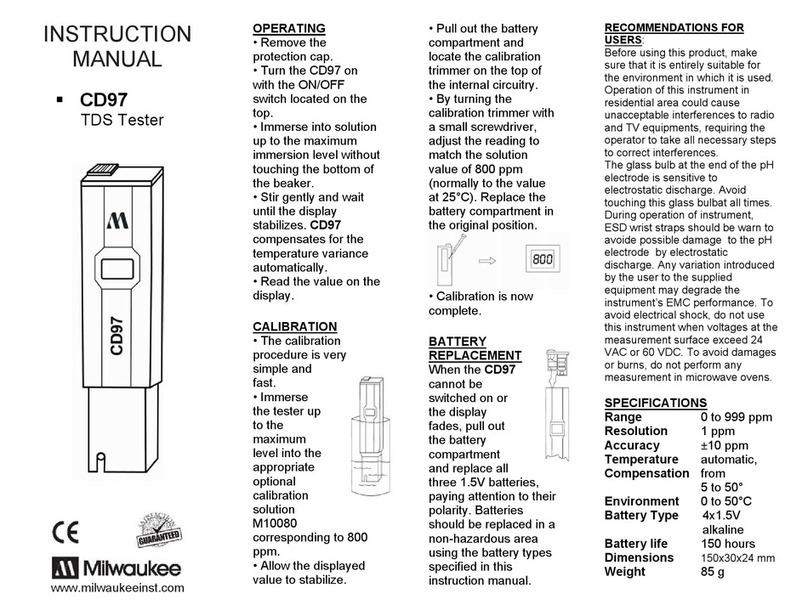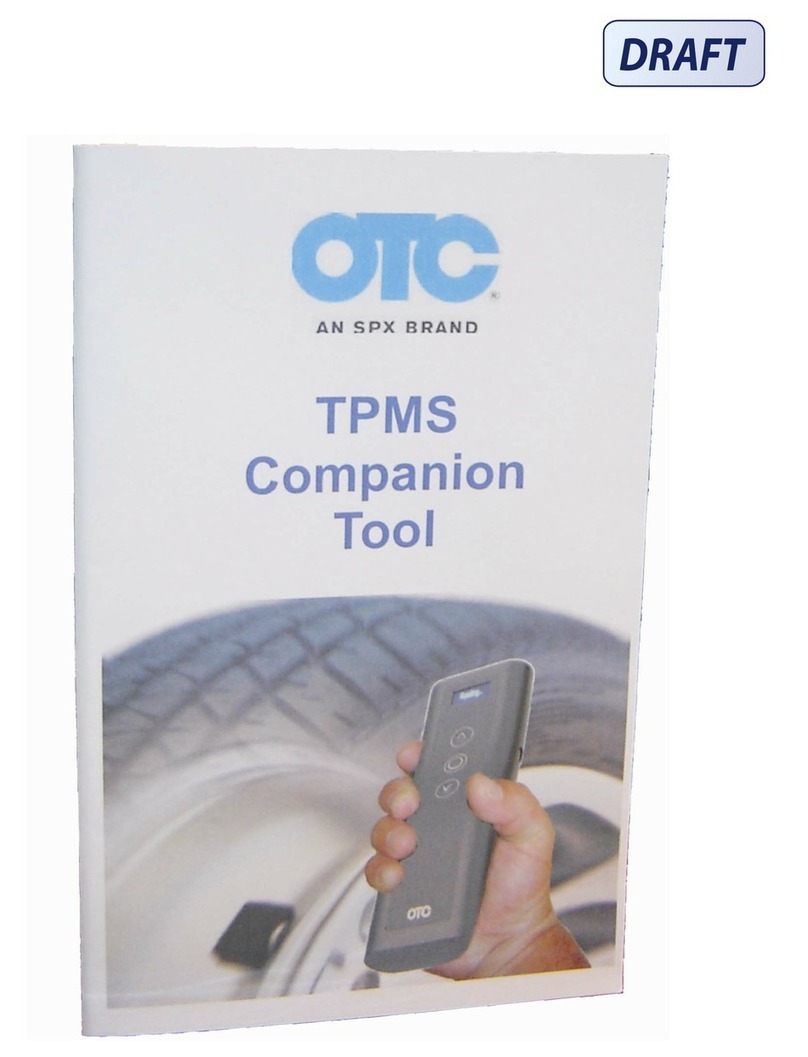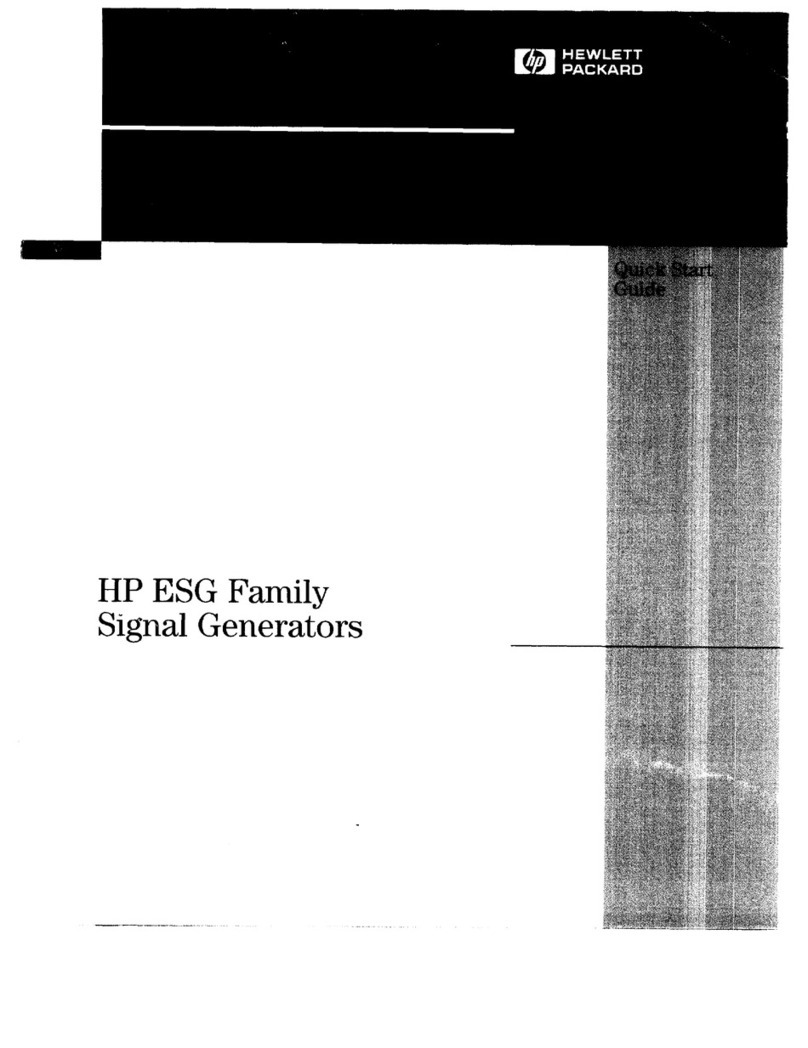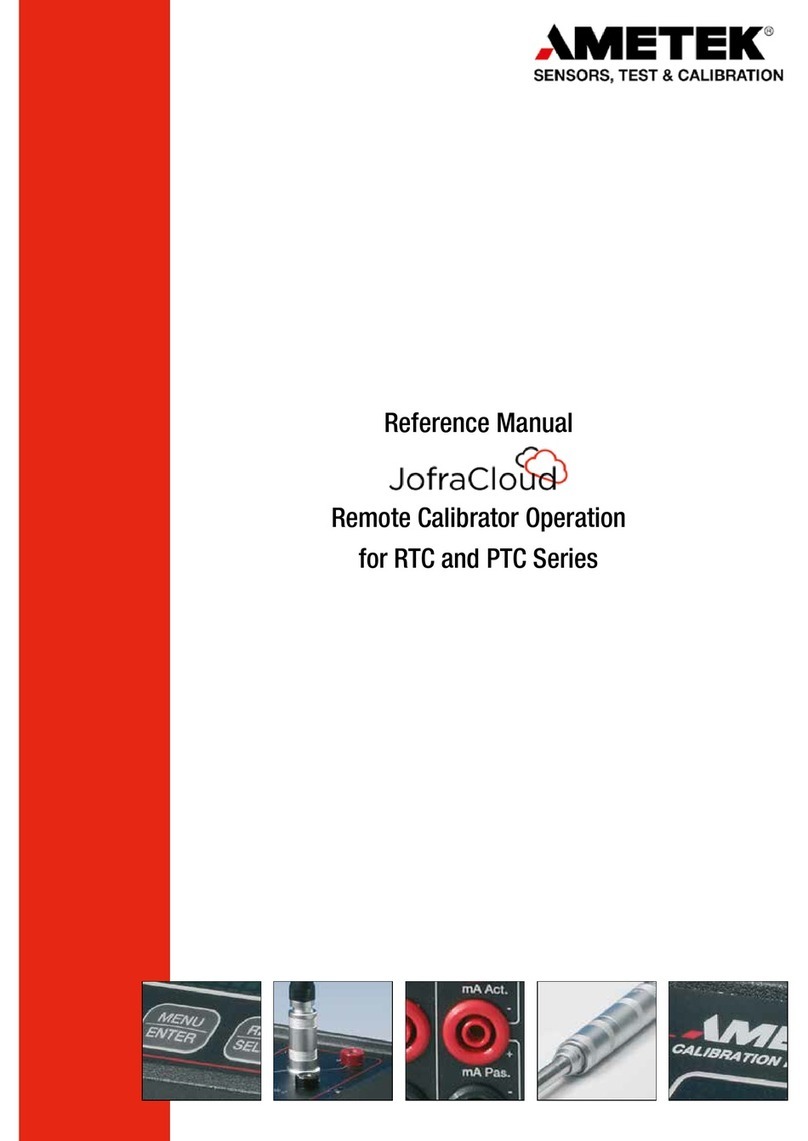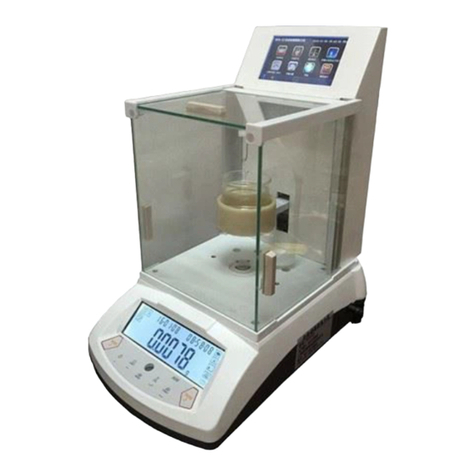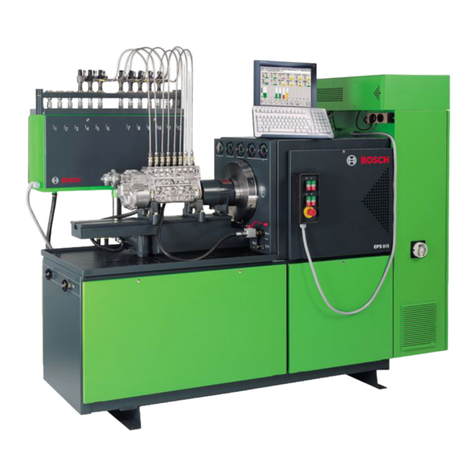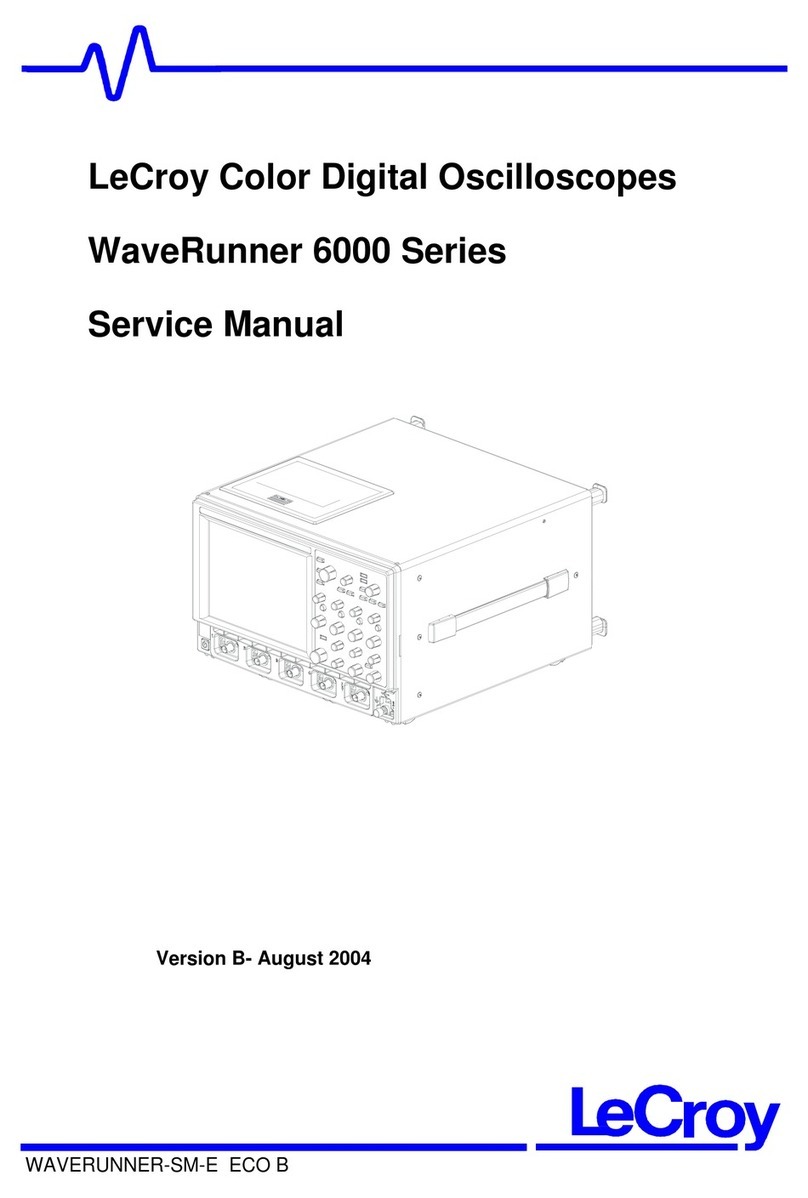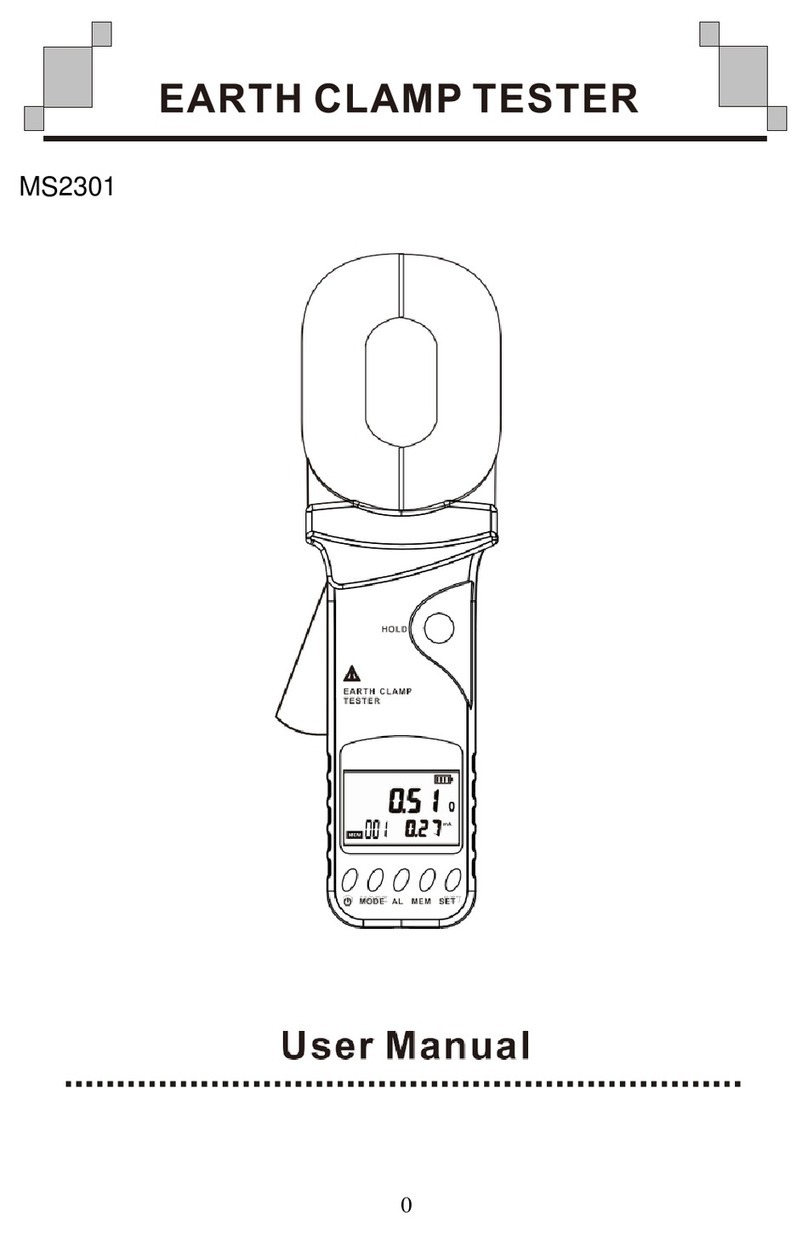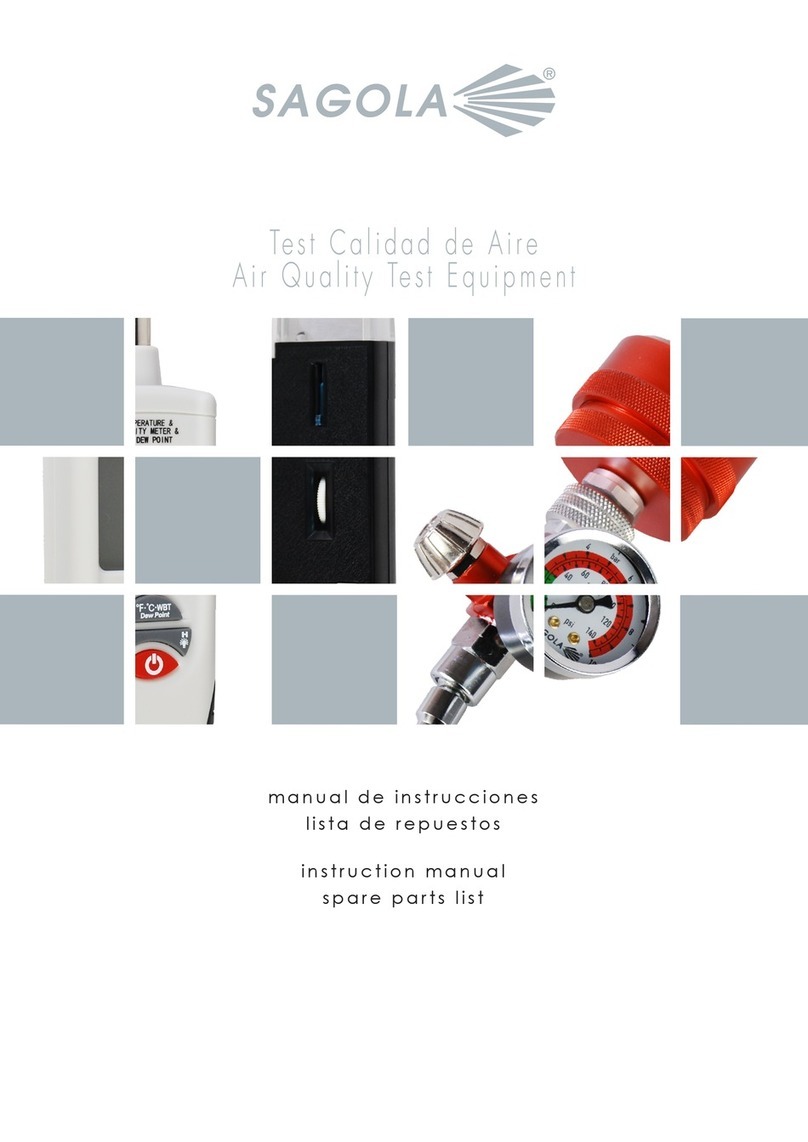BASEWEST TS-420 Installation and operation manual

BASEWEST
Operating & Maintenance
Manual
Model TS-420 Test Set
Revision A
22 June 2010
BaseWest Inc.
4240 116th Ave N, Clearwater, FL 33762
Tel: 727 / 573-2700 • Fax: 727 / 573-4307
E-mail: [email protected]
www.basewest.com
25-60-41

BASEWEST
Operating & Maintenance Manual
Model TS-420 Test Set
Page 2 of 10 25-60-41
24 Jan 2002
1.0 General
This operating and maintenance instruction covers the BaseWest Model TS-420 test set -
a rechargeable, handheld instrument with a digital LCD readout designed specifically for
testing airline escape slide lighting systems and their components. The Model TS-420
comprises the following functions:
•Voltmeter with built-in load bank - This mode is used to test battery condition. A rotary
switch on the instrument panel allows the selection of closed circuit test under
selectable resistive loads as well as an open circuit (no load) test.
•Ammeter with integral power supply - This mode is used to verify the current draw of
the slide light harness through an internal regulated 5VDC power supply. Current
readings can be used to verify proper function of the light harness and, in some cases,
can be used as an indicator of a light-out condition. The ammeter function has a built-
in timer that allows hands-free, walk-around inspection and automatic instrument shut-
down after 20 seconds.
Slide manufacturer component maintenance manuals should be consulted to determine
appropriate test parameters and loads.
Figure 1. TS-420 Test Set with Charger

BASEWEST
Operating & Maintenance Manual
Model TS-420 Test Set
Page 3 of 10 25-60-41
24 Jan 2002
2.0 Theory of Operation
2.1 General
The Model TS-420 provides for voltage testing of escape slide lighting system battery
packs, and electrical current testing of escape slide lighting harnesses. A special interface
connector provides for full system test of an installed battery pack and lighting harness
system through a mating test connector found on most battery packs. The voltmeter and
ammeter modes are selected by a Mode Selector (rocker switch) mounted on the
instrument panel. The voltmeter mode is provided with a multi-value resistive load bank
that can be selected by a panel-mounted Load Selector (rotary switch). The ammeter
mode measures current through the lighting harness provided by a built-in regulated 5VDC
power supply. Tests are initiated through a guarded Press-To-Test switch
2.2 Voltmeter Mode
The voltmeter mode is used to test battery condition. The voltmeter mode is selected
when the Mode Selector switch is in the VOLTMETER position. In this mode, the Press-
To-Test switch is a momentary push button - the instrument is ON only so long as the
switch is depressed. When the test switch is pressed, the Self-Test indicator illuminates
GREEN and the voltage of a connected battery pack is displayed on the digital meter. The
battery under test is subjected to the resistive load selected by the panel-mounted rotary
switch. Positions A through F are resistive loads exactly matching those of test equipment
described in slide manufacturer manuals; a NO LOAD position is offered to allow open
circuit voltage testing of the battery. The Battery Status indicator is not active in this mode.
2.3 Ammeter Mode
This mode is used to measure the amount of current being drawn through the lighting
harness under a 5VDC regulated input. The ammeter mode is selected when the Mode
Selector switch is placed in the AMMETER position. Activating the Press-To-Test switch
in this mode provides 5VDC regulated power to the output connectors, and initiates a 20
second timer. The power supply and meter turn off automatically approximately 20
seconds after the test switch is pressed. The device will remain on and active so long as
the momentary switch is pressed in, but will return to the OFF condition if the switch is
released after the initial 20 second period. In the ammeter mode, the Self-Test indicator
illuminates GREEN, indicating that the internal power supply is providing 5.0 VDC and the
unit is OK for test; if the Self-Test indicator illuminates RED, the test set must be removed
from service and recharged. The Battery Status indicator, if illuminated, indicates that the
internal battery pack is low and recharging is required.
NOTE: The device is OK for test and can continue to be used in either mode so long
as the Self-Test illuminates GREEN when the Press-To-Test switch is activated.

BASEWEST
Operating & Maintenance Manual
Model TS-420 Test Set
Page 4 of 10 25-60-41
24 Jan 2002
Figure 2. TS-420 –General Arrangement
3.0 Battery Testing (Voltmeter Mode)
3.1 Move the Mode Selector switch to VOLTMETER.
3.2 Connect the 4-contact test lead on the battery pack to the mating receptacle on the
connector block of the instrument (See Figure 3). Note that the connector is keyed for
proper alignment.
3.3 Select the proper test load (NO LOAD, or positions A through F) on the Load Selector
switch. Refer to OEM manuals for correct test load setting. The NO LOAD position
provides an open circuit test of the battery pack.
3.4 Press-To-Test; record voltage of the battery pack under the selected condition. The Self-
Test indicator must illuminate GREEN at this point. If not, see Section 6.0
3.5 Release the Press-To-Test switch when the voltage is recorded. The test set will return to
the OFF condition. NOTE: This test can also be accomplished by connecting one set of
the battery power lead connectors to the VOLTMETER inputs on the connector block (see
Figure 3).
LCD Meter
Self Test Indicator
(Green / Red LED)
Battery Status Indicator
(Amber LED)
Mode Selector Switch
(Voltmeter/Ammeter)
Load Selector Switch
Press to Test
AC Charger
Receptacle
Connector Block
(See Fig 3)

BASEWEST
Operating & Maintenance Manual
Model TS-420 Test Set
Page 5 of 10 25-60-41
24 Jan 2002
Figure 3. Connector Block Arrangement
4.0 Light Harness Testing (Ammeter Mode)
4.1 Select the Mode Selector switch to the AMMETER position.
4.2 Connect the light harness to be tested to the connector block at the head of the instrument
(See Figure 3) according to the following configuration options:
a) Installed slide light systems with battery packs - Connect the battery pack's 4-contact
test lead plug to the 4-pin receptacle on the instrument's connector block
Ammeter/Power Supply
connection for
Light Harness Test
System Test connection for
Battery & Light Harness Test
Voltmeter Connection
for Battery Test

BASEWEST
Operating & Maintenance Manual
Model TS-420 Test Set
Page 6 of 10 25-60-41
24 Jan 2002
b) Installed slide light systems without battery packs - Connect harness to the instrument
block via the OEM-identified power input; special test accessory cables may be
specified.
c) Individual slide light harnesses with Amphenol-type connectors - Connect the
Amphenol-type receptacle/socket into the recess pin terminals on the connector block
marked AMMETER. Observe polarity on LED-based systems. BaseWest LED
systems use the following convention: BLUE (+), WHITE (-).
d) Individual slide light harnesses without Amphenol-type connectors - Connect
harnesses to the instrument block via an appropriate interface test lead, such as an
alligator clip lead.
4.3 Actuate and release the Press-To-Test switch. Confirm that the Self-Test indicator
illuminates GREEN. If this indicator is RED, remove unit from service for recharging (see
Section 5.0).
NOTE: If the Self-Test indicator is on (GREEN) and the Battery Status indicator is on
(AMBER), the test set is OK for test, but should be recharged at the next opportunity.
4.4 Read current (milliamperes) on the digital meter. Confirm that the current reading is within
OEM-specified tolerances.
5.0 Internal Battery Recharging and Replacement
5.1 General
The TS-420 is provided with a rechargeable Ni-Cad pack, P/N 6-1035, which is designed
to provide hours of service. When the Battery Status indicator comes on (AMBER), it is
an indication that the internal battery is a low capacity, and recharging will soon be
required. If the Self-Test indicator comes on RED, the internal battery voltage is too low to
provide accurate test results and must be recharged before the unit is returned to service.
5.2 Battery Recharging
a) Connect the battery charger, P/N 36-1002, to a standard 115-120VAC outlet.
NOTE: International customers must use an appropriate adapter for 110VAC service,
or a converter for 220VAC service, depending on the country.
b) Connect the charger output plug into the receptacle in the side of the TS-420 test set.

BASEWEST
Operating & Maintenance Manual
Model TS-420 Test Set
Page 7 of 10 25-60-41
24 Jan 2002
Figure 4. Internal Battery Charging Arrangement
c) The battery should be left on charge for approximately eight (8) hours, or overnight.
After charging, disconnect the charger and place the Mode Selector switch into the
AMMETER position and Press-To-Test. If the Self-Test indicator illuminates GREEN,
and the Battery Status indicator is OFF, the unit is sufficiently charged to return to
service.
NOTE: If the unit must be used before full charge is reached, the unit may be returned
to service temporarily if the Self-test indicator and the Battery Status indicators are
both on (GREEN and AMBER, respectively). The unit MAY NOT be returned to
service if the Self-Test indicator is RED.
d) If the Self-Test indicator comes on RED after a full charge cycle, the test set should be
returned to BaseWest for service.
5.3 Battery Replacement
The internal rechargeable Ni-Cad battery should provide several years of service. Use the
following procedure to replace the battery when necessary.
a) Turn the test set face down on a stable surface. Remove four (4) screws on bottom of
instrument case.
Charger Receptacle
AC Charger
P/N 36-1002

BASEWEST
Operating & Maintenance Manual
Model TS-420 Test Set
Page 8 of 10 25-60-41
24 Jan 2002
b) Carefully remove the bottom portion of the instrument case and lay aside.
Figure 5. Internal Battery Access
c) Locate the battery lead wire, and follow it to the connector on the PC board. While
securing the instrument with one hand, carefully disconnect the battery connector from
the PC board and remove the battery. (NOTE: The battery is secured by mating
patches of Velcro. Use care in removing the battery pack; do not use excessive force)
Figure 6: Battery Removed
Battery Pack
Battery Connector
Velcro Patch / Hook
(Attached to Test Set)
Velcro Patch / Pile
Attached to Battery)
P
Part of Battery

BASEWEST
Operating & Maintenance Manual
Model TS-420 Test Set
Page 9 of 10 25-60-41
24 Jan 2002
d) Install the replacement battery exactly as before. Center the battery over the Velcro
pad and gently press into place.
e) Carefully re-connect the battery connector to the PC board. Note that the connector is
keyed to prevent misalignment.
f) Replace bottom portion of case and secure with four screws.
6.0 Indications & Troubleshooting
6.1 Voltmeter Mode
The following Indications apply when the VOLTMETER mode is selected and the Press-
To-Test button pushed:
a) Self-Test indicator is GREEN - Test set is operational and OK for test
b) Self-test indicator does not illuminate - Test set requires servicing; return to BaseWest.
c) LCD meter displays DC volts in the range of 0.00 to 19.99; if not, return for repair.
6.2 Ammeter Mode
The following Indications apply with the instrument switched to the AMMETER mode and
the Press-To-Test button is pushed:
a) Self-Test indicator is GREEN, Battery Status indicator is OFF - Test set is operational
and OK for test; battery charge level is medium to high.
b) Self-Test indicator is GREEN, Battery Status indicator is AMBER - Test set is
operational and OK for test, but internal battery is getting low. Recharge the internal
battery at the next opportunity.
c) Self-Test indicator is RED, Battery Status indicator is AMBER –Remove from service
and recharge. If normal indications do not re-appear, return to BaseWest for service.
d) Self-Test indicator is OFF - Test set requires servicing; return to BaseWest.
e) LED meter should display milliamperes in the range of 0 to 1999 mA (no decimal)
7.0 Care and Maintenance
7.1 The TS-420 test set is a sensitive electronic instrument; it should be treated and protected
with appropriate care.
•Do not drop or crush the instrument

BASEWEST
Operating & Maintenance Manual
Model TS-420 Test Set
Page 10 of 10 25-60-41
24 Jan 2002
•Do not apply external electrical inputs, except AC charger
•Keep instrument away from all fluids
•Protect from extreme temperatures, weather/rain, extended UV radiation
7.2 The device is designed for handheld use in a shop and field environment but is not
designed to withstand a drop to the ground or to survive excessive compression loads.
7.3 The device is splash resistant, but not waterproof; do not allow the device to sit in standing
fluids or subject to rain. Excessive exposure to UV can affect the LCD meter.
7.4 Surface cleaning only with a slightly damped cloth (water or alcohol) is recommended. DO
NOT use other solvents or cleaners.
8.0 Calibration and Repair
The TS-420 test sets should be calibrated in accordance with the user's quality assurance
requirements. A separate calibration manual is provided; contact BaseWest for
distribution. Unauthorized field repairs are not recommended, and may void warranty. It
is recommended that the devices be returned to BaseWest for repair or servicing.
Other BASEWEST Test Equipment manuals
Popular Test Equipment manuals by other brands
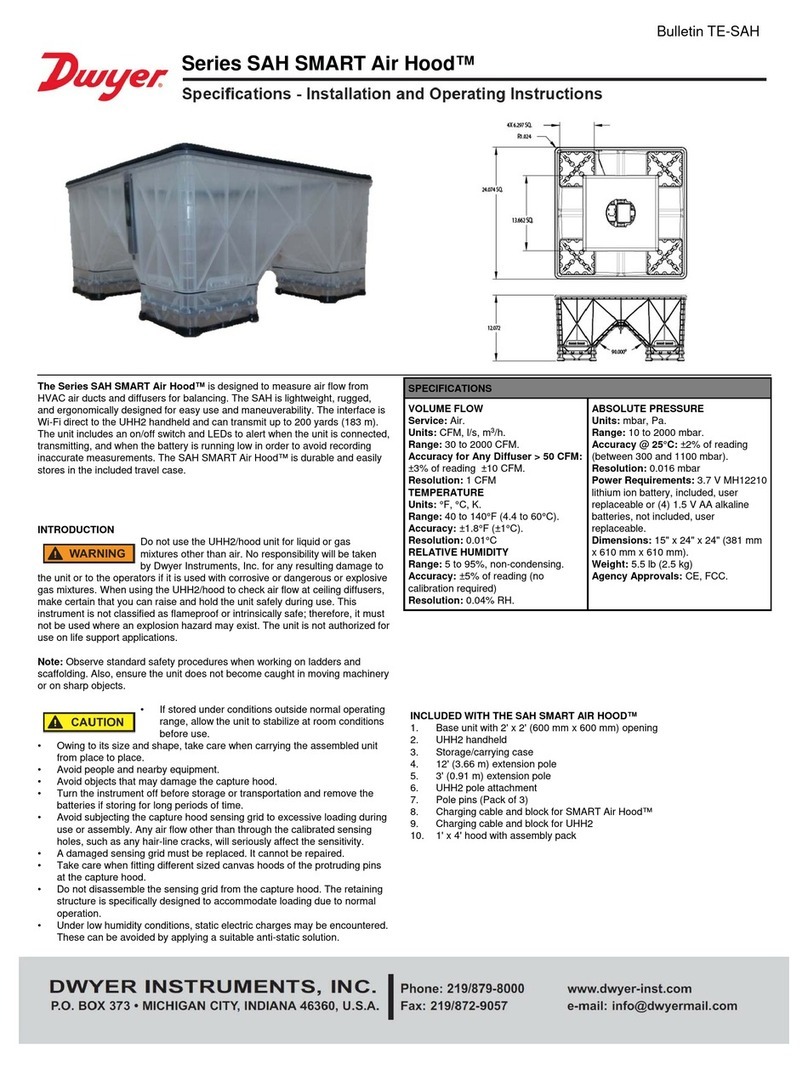
Dwyer Instruments
Dwyer Instruments SAH SMART Air Hood Series Specifications-installation and operating instructions
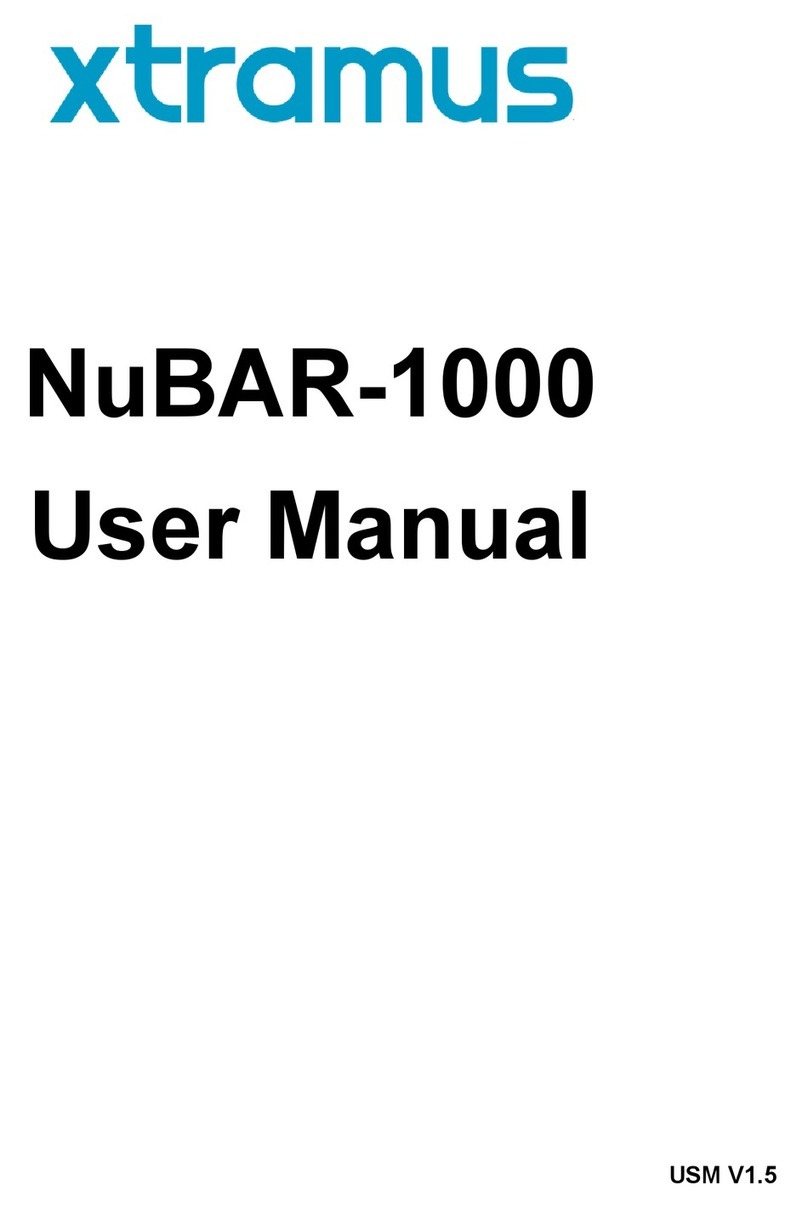
Xtramus
Xtramus NuBAR-1000 user manual
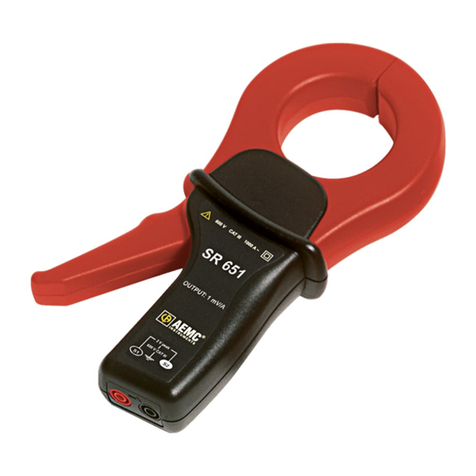
AEMC
AEMC SR652 user manual

Huazheng
Huazheng HZ-662 quick start guide
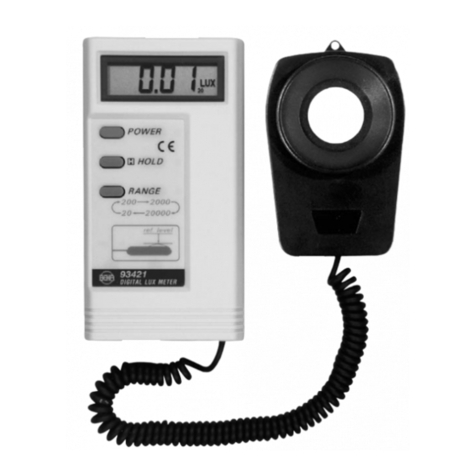
BEHA
BEHA UNITEST 93408 instruction manual
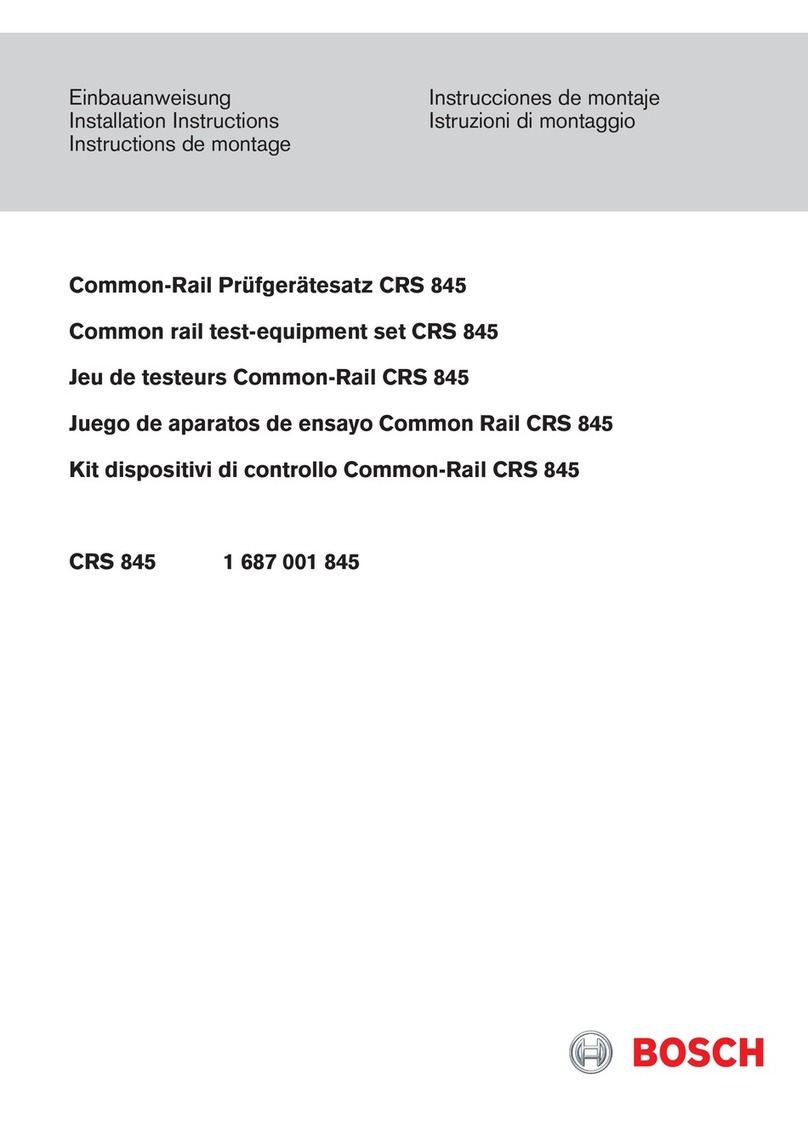
Bosch
Bosch CRS 845 installation instructions
